
American Congregational Building
Great place to learn how religion shape this country.
Next to the Massachusetts State House is a building with some unusual architecture. This is the home of the American Congregational Library.

Six Things I learned about the American Congregational Library.
- The Congregational Library began in 1853 with 56 books, but they didn't have a physical building until 1898. (The original 56 books are still in the collection!)
- In 1957, the Congregation headquarters moved from Boston to New York - leaving lots of office space. Over the years Non-profits had occupied the space.
- On August 3, 2017 the Association sold it 14 Beacon Street to Faros Properties for $25.4 million. The library will stay in the building. The money from the sale will be used to maintain the reading room. The sale may impact business that occupy the above floors.
- The library is home to New England's largest Clergy Obituary Database - Researchers can search over 30,000 obituary listings for clergy and missionaries spanning more than three centuries. Great way to learn more about clergy and missionaries that might have started your Congregational church.
- This is a interesting stop for Boston Tourist as you can learn a lot of about how religion shaped this nation.
- Building is not on the Boston Historic Landmarks - there has never been a petition to preserve the building architecture.
Did you know: A Massachusetts law of 1659 punished offenders with a hefty five shilling fine for celebrating Christmas. It would be interesting to read up on documents from that time period about this - something that can only be done at the American Congregational Library.
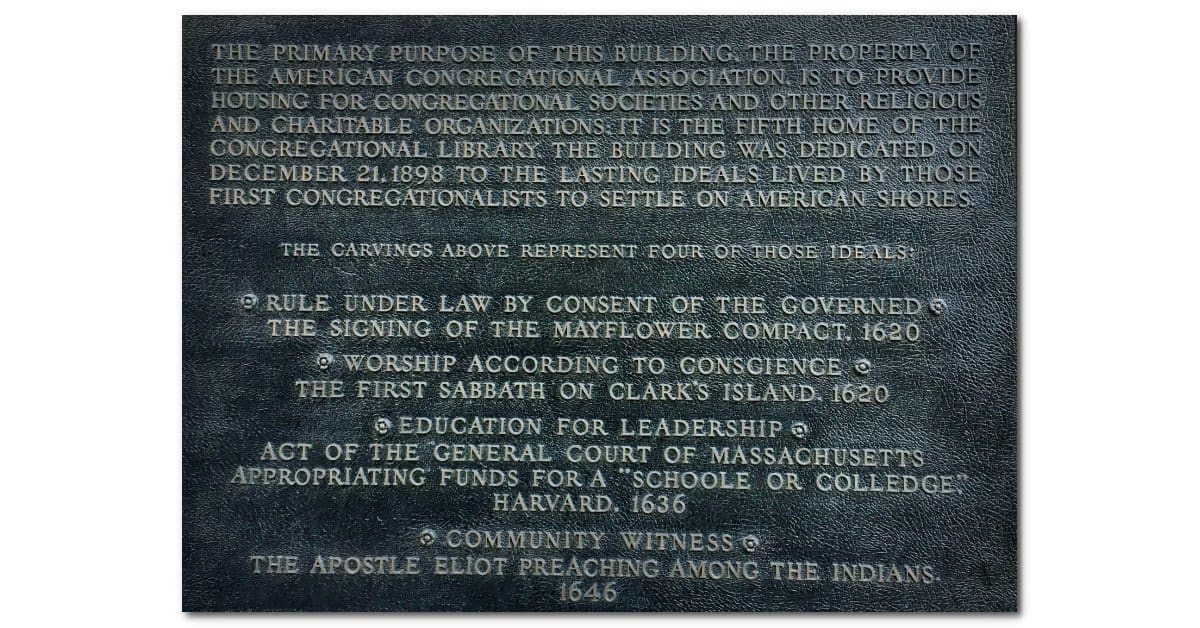
Sign on the Building
Building Plaque
This is the transcript of the sign on the building:
The primary purpose of this building, The Property of the American Congregational Association, is to provide housing for Congregational Societies and other religious and Charitable Organizations. It is the Fifth home of the Congregational Library. The building was dedicated on December 21, 1898 to the last ideals lived by those First Congregationalists to settle on American Shores.
The carvings above represent four of those ideals:
- Rule under law by consent of the Governed - The signing of the Mayflower Compact, 1620.
- Worship According to the Conscience - the First Sabbath on Clark's Island, 1620.
- Education for Leadership - Act of the General Court of Massachusetts Appropriating Funds for a "Schoole or Colledge," Harvard, 1636
- Community Witness - The Apostle Eliot preaching among the Indians. 1646.
Finding the American Congregational Building
The American Congregational Building is located next to the Massachusetts State House. It's located on the second floor of 14 Beacon Street.
The library collection is open to the public.
PermalinkRead Your Way to Fenway 2019
Boston Students should take a chance and enter the contest
Every year the Boston Public Library has a contest with the ultimate goal to encourage students to read and write over the summer break. It's called "Read Your Way to Fenway."
This contest encourages students to read over the summer and get a chance to see the Red Sox. This contest is open to all Boston Public Library holders.
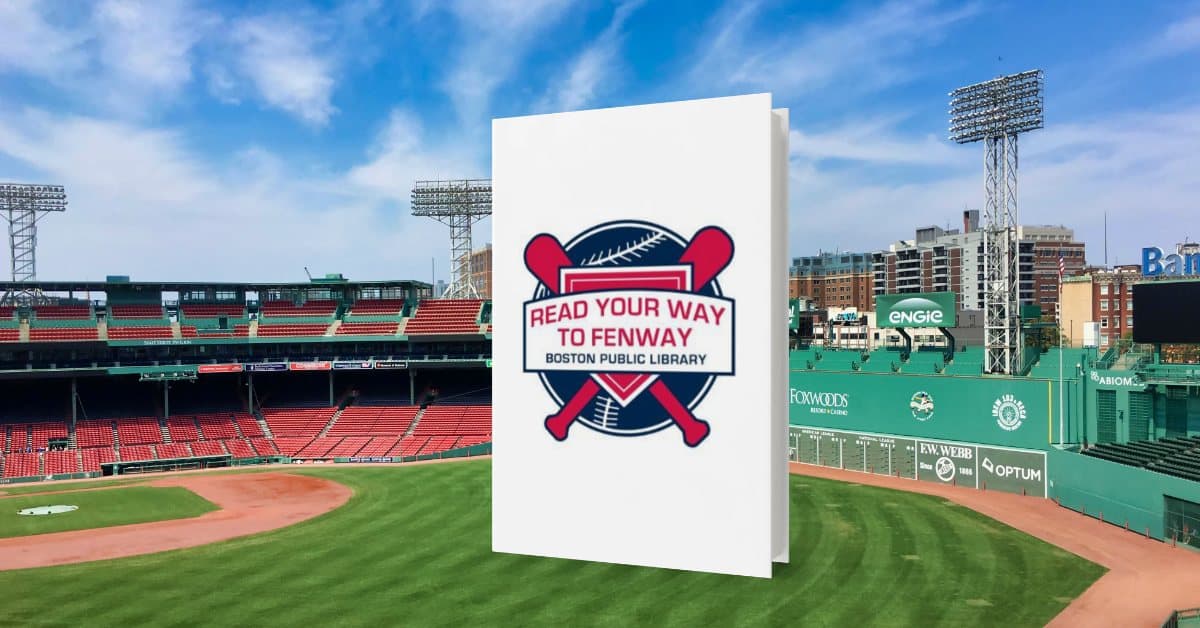
Four Fun Facts about the Contest
- In the past, the Library usually announces the contest right around the last week of school.
- This annual event started in 1995. This year is the 24th annual tradition.
- In 2017, 624 children participated in the program and more than 500 winners were chosen.
- There are 54,312 students in the Boston Public Schools. So your chances of winning is actually pretty good!
- Some of the readers actually get to go on the field before the game and meet some of the Red Sox players.
Important Dates
- Contest usually starts: June 1
- Essays due to a Boston Public Library location: Friday, July 27
- Winners notified: August 6-10
- Pick up your tickets at your branch library: August 13-17
- Game day: Sunday, August 19, at 1:05 p.m., Red Sox vs. Tampa Bay Rays at Fenway Park
Vendome Hotel Fire Monument
A special monument to nine fire fighters that died in a fire in 1972
This year marks the 47th anniversary of the Vendome Hotel fire. The hotel was located on Commonwealth Ave Mall, near Dartmouth Street.
On June 17th, 1972 the building caught on fire. Nine firefighters were killed while trying to put out the fire. To this day it is still the worst fire in Boston's history.
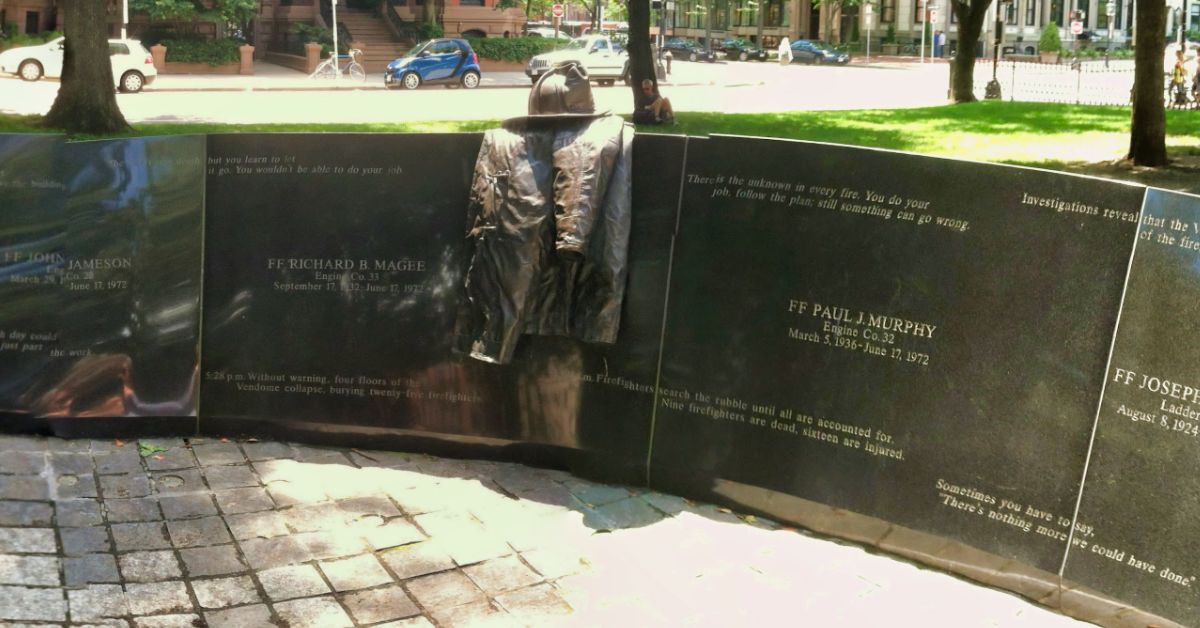
Eleven things I learned about the Hotel Fire
Hotel Vendome was completed in 1871 - named after a similar hotel in Paris. In 1882, it was the first hotel in America to have electric lights - Thomas Edison stayed at the hotel to personally see it.
The hotel suffered during the depression. On December 28, 1969, a fire broke out in the hotel - when the top three floors were badly damaged. The owners couldn't recover from the fire and sold the hotel a couple of years later.
The new owner was upgrading the hotel to the apartment and a two-floor shopping area.
At the time of the fire, the building was still under construction. There were 100 people in the cafe and some construction workers upstairs. An electrician was the one that reported the blaze by pulling a local firebox around 2:35 pm
By 3:06 the fire went to four alarms.
At 5:20 pm, the southeast corner of the building collapsed trapping and crushing nine firefighters. (The southeast corner faces Dartmouth street.)
The collapsed occurred during a shift change when a large number of firemen were out of the building. There were 25 firemen in the building when it collapsed occurred.
The fallen were Thomas W. Beckwith, Joseph J. Boucher Jr., Joseph P. Saniuk, John E. Hanbury Jr., Thomas J. Carroll, Paul J. Murphy, Richard B. Magee, John E. Jameson and Charles E. Dolan.
It took 50 firemen nine hours to recover all the bodies from the fire.
One other woman died in the fire.
The actual cause of the fire has never been determining. In addition, Fire Marshal also wasn't able to determine where the fire started. It is believed that it was an accident and not intentionally set.
You can learn a lot more detail about the fire on the Boston Fire History website.
Monument
The monument was dedicated on June 17, 1987 - the 25th anniversary of the fire.
It is located diagonally across the street of the former Hotel Vendome.
There is a timeline on the monument, as you read through it your facing towards the former hotel.
The memorial was designed by Ted Clausen and architected by Peter White.
Other Tragic Fires
November 15, 1942 - Six Firemen died at the 110-year-old Lyceum Hall in East Boston.
October 1, 1964 - Four Firemen died at a toy factory on Trumbull Street in the South End.
PermalinkPope John Paul II visits Boston
Pope John Paul II first stop in the United States was in Boston
Pope John Paul visited the United States of America on October 1st-8, 1979 - the first visit of the Pope to America. His Apostolic Journey began in Boston.
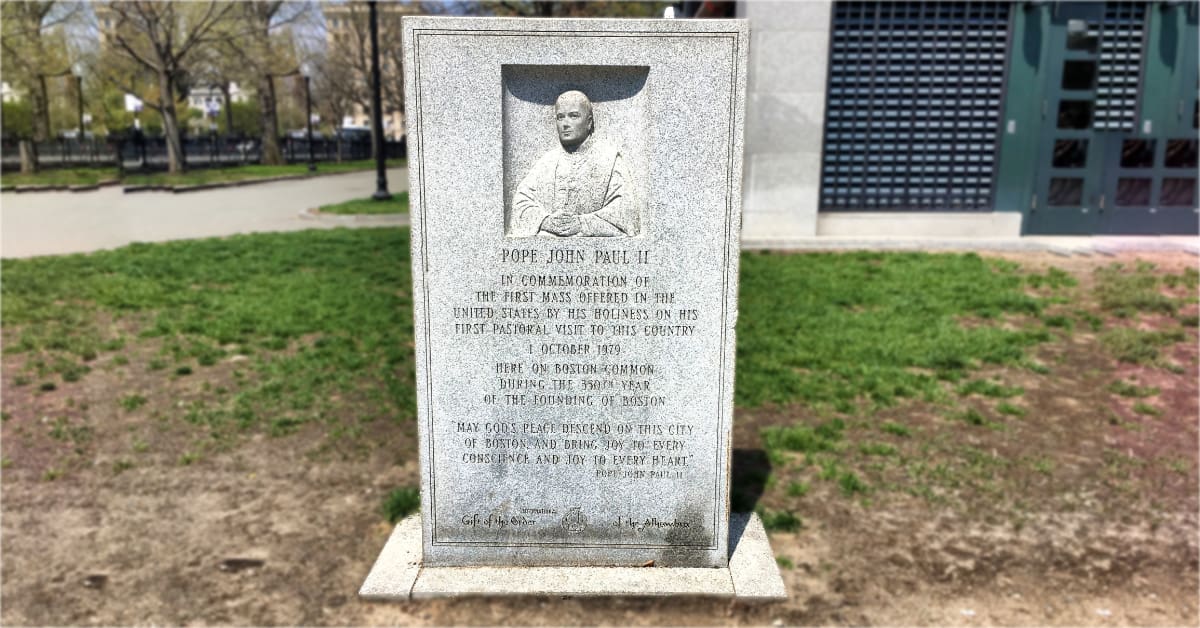
A monument of Pope visit is near the location of where the Pope Spoke in 1979.
Ten Things I learned about the Pope's Visit to Boston
In July 1976, Cardinal Wojtyła spent the summer traveling North America giving speeches - including one at Harvard University. In 1979, he was elected Pope and took the name Pope John Paul II.
Pope John Paul left Ireland the morning of October 1st, and landed in Boston and kiss the American soil at 3:02 pm. Was greeted by Mrs. Rosalyns Carter along with other distinguish Massachusetts politicians.
It took 55-minutes to get from Logan Airport to Dorchester - as the motor cage traveled slowly as people wanted to see the Pope.
He said his first Mass in the United States at the Cathedral of the Holy Cross with 2,000 local priests in attendance.
Later that day, Pope John Paul II celebrated his first North America outdoor Mass at the Boston Public Commons - an estimated 400,000 people attended the service.
The Mass was to start at 5:30 pm, but he was about 20 minutes late
The service lasted an hour and a half as the crowd stood during a heavy rainstorm. His homily lasted 37-minutes.
He gave communion to 160 individuals - while 300 priests served communion to the crowd.
After saying the Mass, he left to spend the night at the Cardinal Medeiros home in Brighton.
You can read all the speeches that he gave in American on the Vatican website.
Monument Installation
A Monument was proposed to the City of Boston Park and Recreation Commission on February 12, 1981 (5-Months after the Pope visit) The initial request was turned down because they didn't have the correct approval from the Art Commission and Friends of the Public Garden.
Once the monument team got the correct approval, they met with the City of Boston Park and Recreation Commission again and received approval on May 27, 1981.
The monument was installed near the location of the altar during the Mass.
The monument was paid for by funds raised by the Order of the Alhambra.
Large Crowds
The fact that 400,000 people attended the Mass at the Boston Public Gardens is impressive. Consider the following:
- Weather Factors: The heavy rainstorm certainly was a reason for people to avoid outdoor service. (In fact, some people had to seek shelter because of the lightning storms.)
- Day of the Event: October 1st, 1979, was a Monday - people would have likely taken the day off - even for a 5:30 service.
- Getting to Boston: Public Transportation today is much better than it was in 1979. Today the MBTA is able to handle the 3.2 million fans turning out for the 2004 Rolling Rally to celebrate the 2004 Red Sox. Most people would have driven into the city - I am sure the traffic was busy with the evening commute. (No Red Sox game as they failed to make the playoffs)
Interesting Discovery
The Boston Public Library has a collection of documents from the Pope's visit. These are on reserved and not for checking out of the library.
When I went to the library earlier this week, I was told that the documents have gone missing. The librarian informed me that this occasionally happens when people misplace certain documents.
PermalinkJapanese Temple Bell
Not everyone knows about a 343-year old bell in the Fenway.
In Boston's Fen area, near the World War 2 memorial, is an old Japanese Bell. I have discovered that there is a bit of history on how this 343-year old bell ended up in Boston. (You won't find this on the sign at the Bell.)
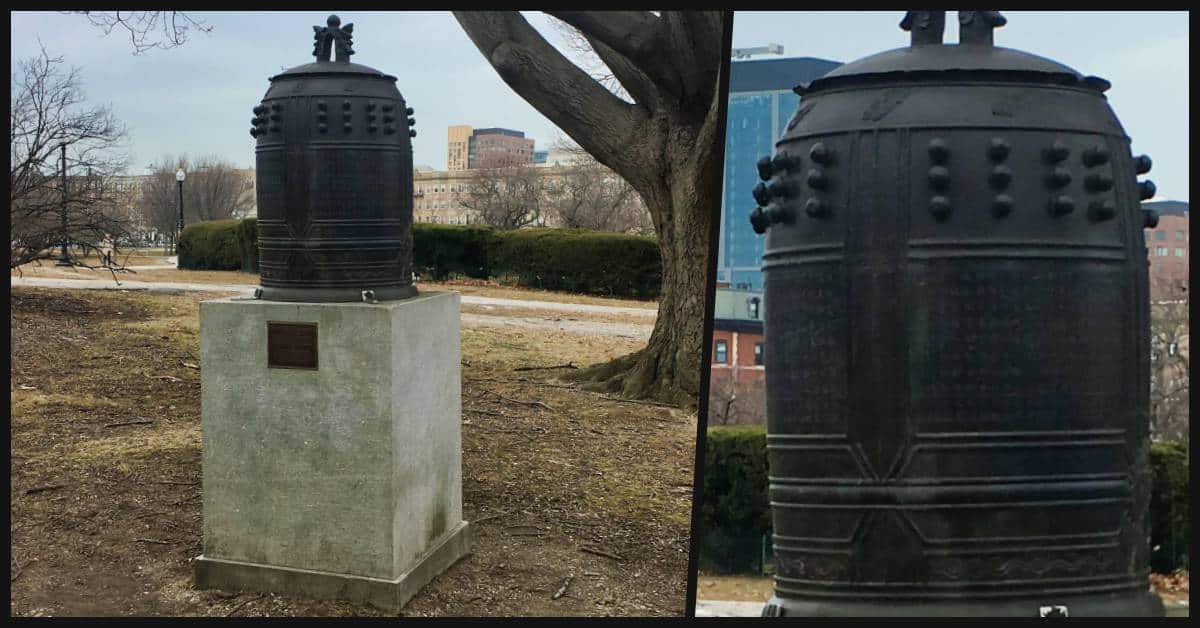
Ten Things I Learned About the Japanese Temple Bell
The Bell weights 450-pounds and is four foot tall.
The Bell Came from crew members of the USS Boston from Japan after the Second World War.
The Bell was discovered by US Navy crew members in a scrap yard in Yokosuka, Japan.
After the war, the USS Boston docked at San Francisco and the Bell was shipped to Boston - cost $42.80 in transportation charges. ($557.94 in 2019 value)
The Bell was given to the City of Boston by Captain Marion R. Kelly - who had retired after the War after nearly 29-years of service.
Originally installed on the Boston Commons on April 25th, 1946. It was moved to the Back Bay Fens in 1953.
There is a small plaque that says the bell was cast in 1675 - Making the Japanese Temple Bell the oldest man made object on display in Boston. (The only this possibly older is the MillStone by Haymarket)
Shortly after the Bell was moved to the Fenway to a permanent location. Some Bostonians wanted the Navy Department to take another look on how the Bell was obtained after the war. Some people thought it was looted from a Buddhist or Shinto Temple in Japan.
The Navy department did an investigation and determined that Boston is the rightful owner of the Temple Bell.
The Bell sits near the World War 2 Memorial, and has face some tough times over the years. The surface is badly corroded. The base has been painted to cover graffiti. The bell is also cracked in several locations.
Plaque beneath the Bell
Temple Bell from Japan
Cast in 1675
Brought to the City of Boston by the Officers and Men of the United States Ship Boston
With the Blessing of the Manpukuji Temple-Sendai as a Symbol of Friendship and a Bond of Peace
Note: Did you notice that the plaque text downplays how the Temple Bell was discovered in World War 2. It makes it sound like it was a gift, when in fact it was taken from Japan during the war. Only later did Japanese officials allow Boston to keep it as a way to rebuild friendship.
PermalinkDuck Tours in Boston
Quite Simply the Best Tour in Boston
If your a first time visitor to Boston, one way to get a quick history of the city is to take one of the famous Duck Boat tours. They are a great way to get some high level understand of what makes the city special and for tourist its a good way to understand the layout of the city.
The Duck Boats are a great way to get pictures of the city skyline from the Charles River.
Old Description from their Website
You've never toured Boston in anything that comes close to Boston Duck Tours. The fun begins as soon as you board your "DUCK", an authentic, renovated World War II amphibious landing vehicle, at the Prudential Center in Boston's historic Back Bay. First, you'll be greeted by one of our legendary tour ConDUCKtors, who'll be narrating your tour. Then you're off on a journey like you've never had before. You'll cruise by all the places that make Boston the birthplace of freedom and a city of firsts, from the golden domed State House to the Boston Common, the Old North Church to fashionable Newbury Street, Quincy Market to the Prudential Tower, and more. And, as the best of Boston unfolds before your eyes, your ConDUCKtor will be giving you lots of little known facts and interesting insights on our unique and wonderful city.
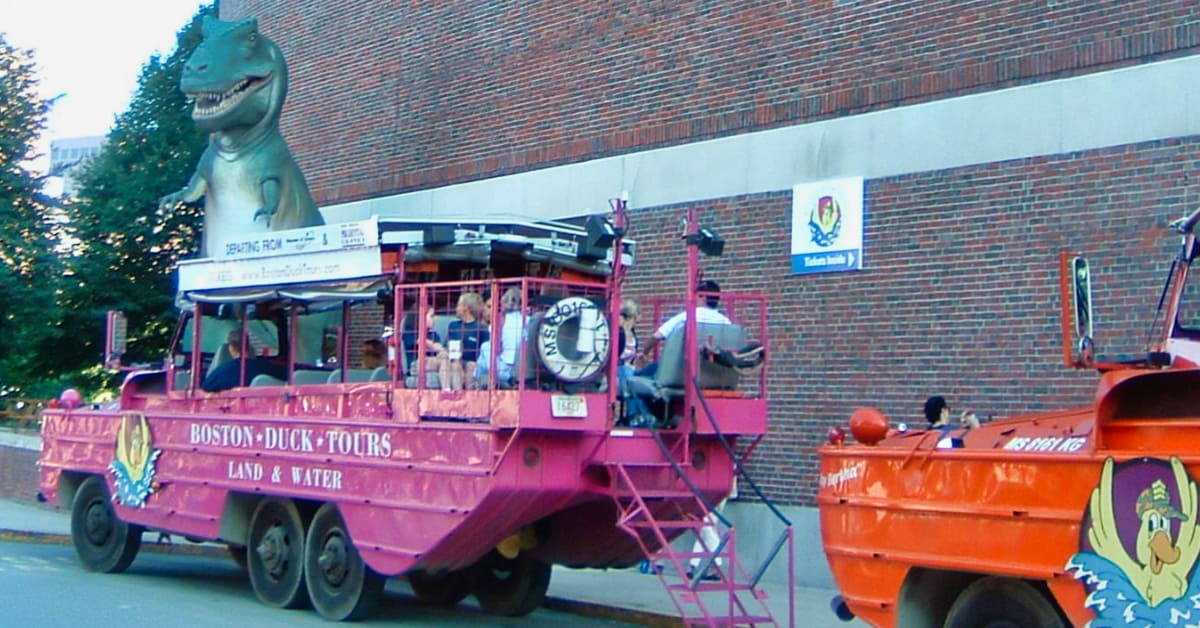
Twelve Fun Facts
- The first Boston Duck Tour was founded on October 5, 1994.
- Each year 600,000 passengers take the tour - making it the most popular tour in Boston.
- All the duck boats run on bio diesel.
- The Boston Duck Tours depart from the Prudential Center, New England Aquarium and the Museum of Science.
- The tours that depart from the Prudential Center and the Museum of Science have the same route.
- You see the same sites on both tours. (The Prudential/Museum of Science tours shows more Copley Square, where as the Museum of Science take you through the Rose Kennedy Greenway and the Financial District.)
- In 2001, it cost $22 to take a tour, in 2019 it cost $42.99.
- Tour tickets do sell out early - usually by noon. To avoid disappointment and running around - buy your tickets in advance.
- You can purchase a Discounted Family pack from tours leaving the Museum of Science.
- If you take the Duck Tour from the Museum of Science you can get discounts on Museum attractions such as $10 off the Exhibit Hall and 10% at the Museum Store.
- You can buy tickets at the Museum of Science, the New England Aquarium, Boston Commons and the Prudential Center.
- Tours last 80 minutes.
Tour Tips
- Make sure to talk to the driver about your interest in Boston - Colonial History, Sports etc. The tour guide will be sure to mention the topic during the tour.
- Arrive at the Duck Tour waiting area early for the best seating.
- Before you board the Duck Boat, you'll be given an opportunity for a group picture. (A better picture opportunity is on the boat or in Front of the vehicle where you can get the name.)
- When your on the water, the driver may ask kids if they want to drive the Duck Boat for a bit. (Great Photo opportunity!)
- The Boats were used in the 2018 Red Sox Parade and the 2019 New England Patriots parade.
- Be sure to look at the inside roof for player autographs!
Which Tour is Better?
So... Which tour is better? The Prudential Center and the Museum of Science route or the New England Aquarium route?
I would recommend taking the Tour from the Museum of Science, as you'll see more Back Bay History and you get better discounts at the Museum - especially if you plan on visiting the Museum.
Is the Tour Worth it?
I believe anyone visiting Boston for the first time should go on the Duck Tour. It's a great way to see the city and get an understand of the lay of the land.
PermalinkRachel Revere Park
General information about the Rachel Revere Park
Rachel Revere Park is a community play area and meeting place. It's located just across the street from the "Paul Revere House" in Boston's North End.
This 3,484.8 SqFt park is owned and maintained by the City of Boston Parks and Recreation.
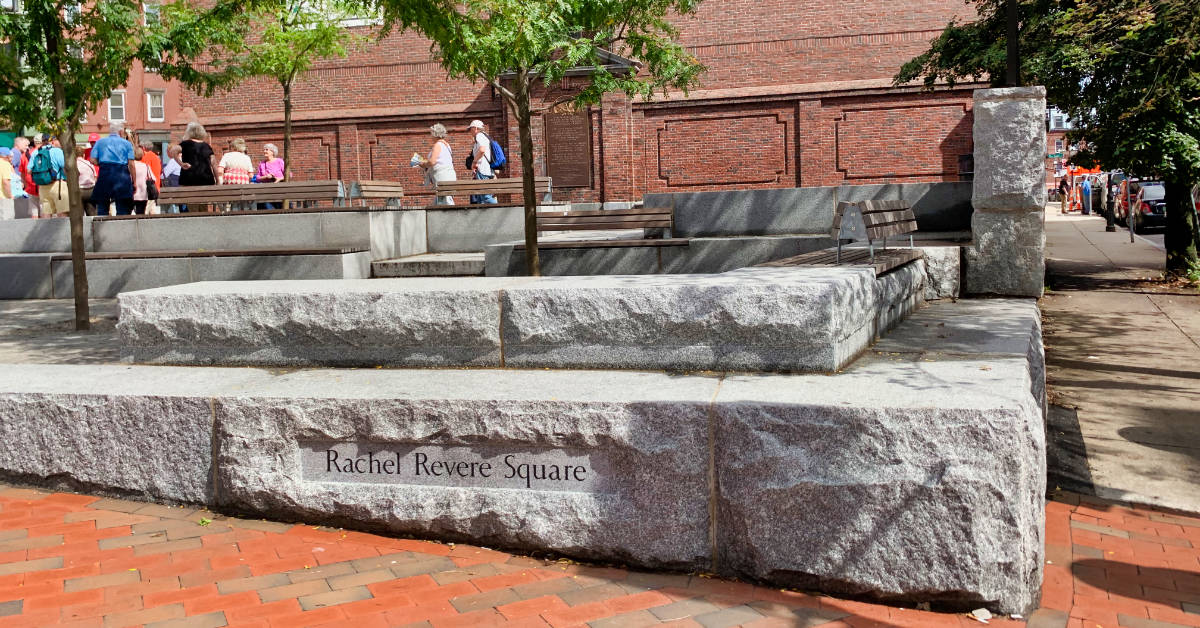
Five Things I Learned about Rachel Revere and the Park
1 Rachel Walker was Paul Revere's second wife. They married on October 10th, 1773.
2 They had eight children:
- Joshua Revere (December 7, 1774 - August 14, 1801)
- John Revere (June 13, 1776 - June 27, 1776)
- Joseph Warren Revere (April 30, 1777 - October 12, 1868)
- Lucy Revere (May 15, 1780 - July 9, 1780)
- Harriet Revere (July 20, 1782 - June 38, 1780)
- John Revere (December 25, 1783 - March 13, 1786)
- Maria Revere (July 17, 1785 - August 22, 1847)
- John Revere (March 27, 1787 - April 29, 1847)
All the children were born before the United States became a country. The United States Constitution officially took effect on March 4, 1789.
3 Rachel Revere died on June 26, 1813, at Sixty-Eight. There is a painting of her at the Museum of Fine Arts that was done just weeks before she died.
4 When Rachel was alive the park was a colonial marketplace.
5 The City of Boston Park and Recreation acquired the park in 1945. The park naming ceremony was at 4 pm on April 19, 1945.
Wall Plaque
At the back brick wall of the park is a plaque that was placed a year after the park was dedicated.
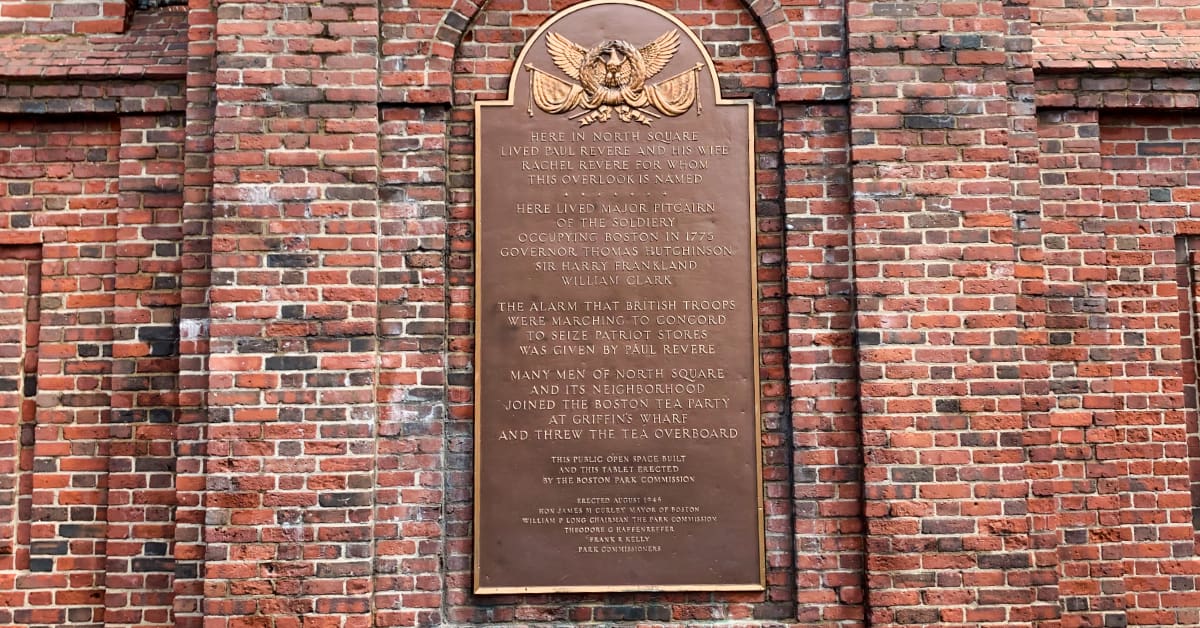
Text of the plaque on the wall:
NORTH SQUARE Bronze
Here in North Square
Lived Paul Revere and his wife
Rachel Revere for whom this overlook is named
Here lived Major Pitcaim
of the soldiery
Occupying Boston in 1775
Governor Thomas Hutchinson
Sir Harry Frankland
William Clark
The alarm that British troops
Were marching to Concord
To seize patriot stores
Was given by Paul Revere
Many men of North Square
And its neighborhood
Joined the Boston Tea Party
At Griffin's Wharf
And threw the tea overboard
This public open space built
And this tablet erected
By the Boston Park Coinmission
Erected August 1946
Hon. James M. Curley Mayor of Boston
VJilliam P. Long Chairman the Park Commission
Theodore G. Haffenreffer
Frank R. Kelley Park Commissioner
Charlie Card
General Information on the popular T card
If you traveling to Boston this summer and planning on using the MBTA for any travel - you should know about the Charlie Card.
CharlieCards are reusable cards that can be loaded with cash value or passes to pay bus and subway fares. CharlieCards are available at select MBTA subway stations.
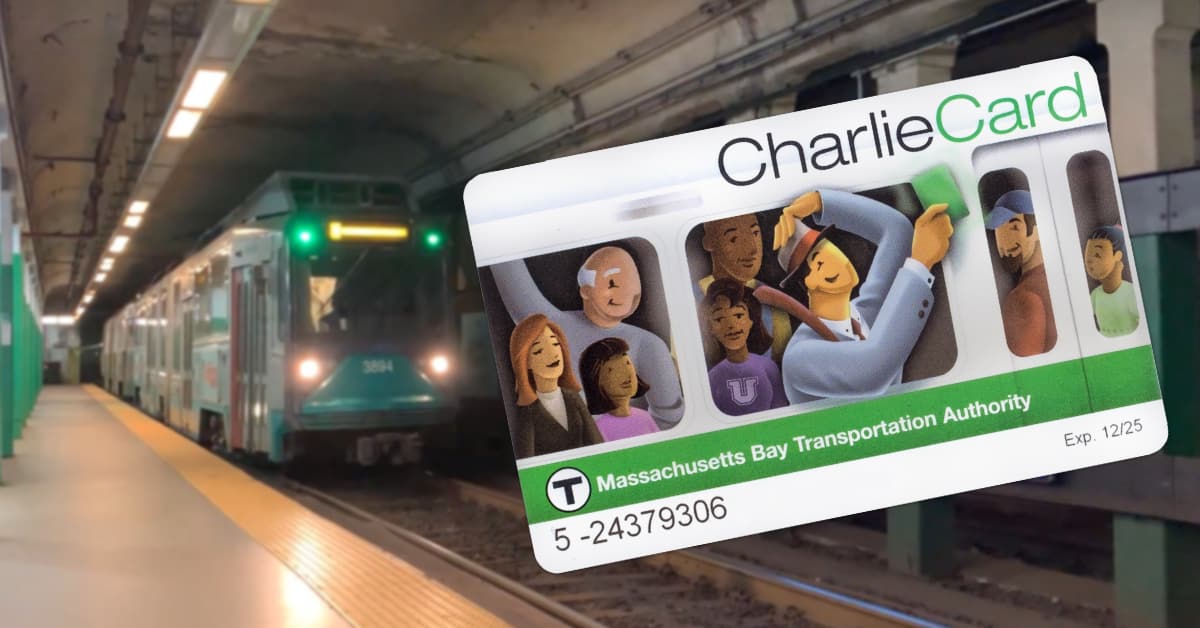
Six Tips on the MBTA Charlie Card
Using a Charlie Card can save you $.50 an every subway travel. The MBTA actually doesn't recommend visitors to carry the MBTA card because they want locals to use it. They recommend the [CharlieTicket](https://charliecard.mbta.com) which can be purchased at any MBTA station.
The only way to check the balance on your CharlieTicket or CharlieCard is at fare vending machines located at any subway stations.
The MBTA doesn't offer any refunds on any unused fare on a Charlie Card.
You can buy Charlie Cards at various stores ([Back Bay Star Market](https://www.yelp.com/biz/star-market-boston-4)) and at various MBTA stations - such as Park Street, North Station, South Station, and Back Bay. The CharlieCard Store at Downtown Crossing is another place to go. (Sorry Charlie no souvenirs here.)
The Charlie Card expires after 10 years. The T can extend the date for another 2 years. (Student CharlieCards expire on the last day of school.)
Two people can share a single CharlieCard with a specific stored value. If you have a monthly or weekly pass, it will only work for one person.
At Logan Airport, there is a CharlieCard Machine near the baggage claim area. You can buy a 7-day pass.
PermalinkJoseph A. Langone Jr. Memorial
Simple memorial at Langone Park in the North End
At the far end of the North End is Langone Park, a medium size park ( 2.34 acreage ) of fun activities. There's a little league baseball field as well as a couple of Bocce Courts. It's a great place to view the Bay as well as the bridges between Boston and Charlestown.
As you walk around the Park may spot a strange white memorial. This is a special memorial to commemorate the people that the park is named after - Joseph A. Langone Jr and Clementine Langone
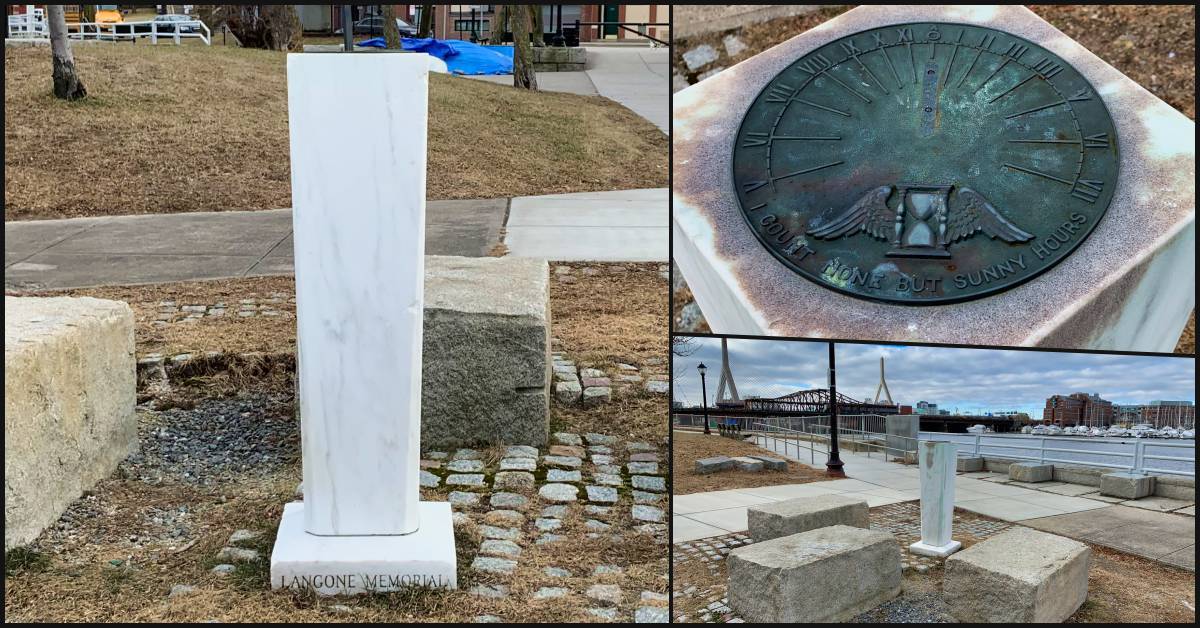
Ten Things that I Learned About the Park and Memorial
-
Old Name
The Park used to be called North End Park then it was North End Beach then WaterFront Park.
-
In 1975 the park was renamed after Joseph A. Langone Jr. (1896-1960) and Clementine Langone (1896-1964)
-
Who was Joseph Langone
Joseph Langone was a Massachusetts state senator from 1933 to 1940 and then a Boston Election Commissioner in the 1940s.
-
Who was Clementine Langone
Clementine Langone was a civic leader from the North End and was well known for her service to the Italian-American community.
-
Naming Ceremony Date
The official naming ceremony occurred on September 13, 1975. Over 200 local residents attended and Mayor Kevin H. White played Cymbals in the band marching around the park.
-
Something Strange I Found
In my research, I found that while the dedication ceremony happened on September 13, 1975 - it was in a Boston Globe article. A formal request for the naming occurred five days later at the City of Boston Parks and Recreation Commission meeting - September 18, 1975. (Not at all sure why this is the case.)
-
City of Boston Error
On the City of Boston Parks and Recreation page it list the park as being Established in 1973. It's not, as indicated above the park new name was established in 1975. In 1973, the Waterfront Urban Renewal process created the Waterfront Park.
-
Sundial
There is a sundial on top of the Langone memorial and the dial is pointing due north. (Also towards the USS Constitution Boat in Charlestown.)
-
Sundial Inscription
Inscribed on the sundial are a "tempus fugit" hourglass with wings as well as the saying "I count none but sunny hours."
-
Park May Disapear!
The biggest threat to Langone Park is rising tides. As part of the Imagine Boston 2030 program, $1,000,000 is now being recommended to add sea level rise mitigation features to Langone Park to prevent flooding. It's also needed to create a resilient waterfront as part of the City's Resilient Boston Harbor and Climate Ready Boston.
Boston Courtyard Copley Square hotel
Beautiful hotel on Exeter Street
As you walk down Exeter Street from Boylston, you may encounter a strange looking building. This is the Boston's Courtyard Copley Square Hotel. This 3-Star rated hotel has 63 king rooms, 14 Queen-double rooms, and 4 suites on 10 floors. It's also 128 years old, one of the oldest hotels on this street.

View of the Courtyard Copley Square from Boylston Street.
The Boston's Courtyard Copley Square hotel and Copley Square Hotel are not the same business. They have similar names but are two different businesses.
Six Things I learned about the Courtyard Copley Square
-
The was once called the Exeter Chambers Hotel, which opened on October 1, 1891. It closed on November 8, 1931.
-
The Hotel was established by Frederick Samuel Risteen - former Massachusetts State Senator. He was also the owner of the Clarendon Hotel.
-
When Frederick Samuel Risteen died in 1903 the hotel was taken over by John Lacey, then it was owned by Ernest Spracklen. In 1907, the hotel was sold at an auction for $327,000 ($8,896,470.33 in 2018 dollars)
-
There isn't much information on the hotel activity between 1907 and 2004. I checked various sites around the web and couldn't find any information about it.
-
Hotel was fully restored in 2004 after the Marriot purchased the property. (There is a sign next to the main entrance)
-
The building exterior features Victorian Eclecticism and Richardsonian Romanesque architectural elements.
The Stained Glass Window
Inside the hotel is a stained glass window that greets every guest.
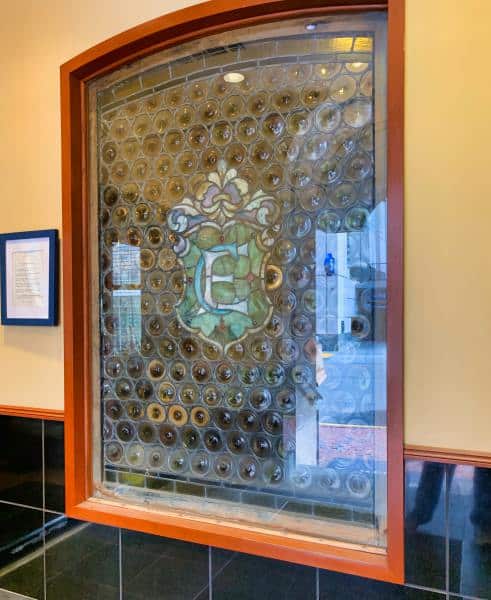
Our century-old arched stained glass window has served as a beautiful entryway greeting hotel guest since 1891.
The emblem EC, can be seen in the center of the glass as the initials of the original hotel called Exeter Chambers.
THis window is representatives of the stained glass that was introduced in the Victorian and Edwardian eras of the 1800's.
However in the late 1800s, American glass makers expanded upon the European cathedral glass. Their creations during this American Art Nouveau period is known as the opalescent glass.
From 1891 to present day, this kaleidoscope of color is a preserved symbol of over 100 years of hospitality here at 88 Exeter Street, Boston.
This window symbolically reflects the illumination of visions for tomorrow guests who have pursued their dream at this residence over the years.
"88 Exeter...the Dream Continues..."
Want a good reason to stay here?
The Courtyard Marriott at 88 Exeter has been ranked #5 in the nation of all Courtyards based upon guest's service scores.
PermalinkAbout
There are many interesting things and places around Boston, MA that you should know about. Here are a few that caught my attention. From historical sites such as the USS Constitution Museum, the Freedom Trail, and the iconic Fenway Park, to modern attractions like the New England Aquarium, the Boston Public Market, and the Isabella Stewart Gardner Museum, there is something for everyone. Whether you are looking for a fun family trip or a romantic getaway, Boston has it all.
Check out all the blog posts.
Blog Schedule
| Sunday 13 | Misc |
| Monday 14 | Media |
| Tuesday 15 | QA |
| Wednesday 16 | Pytest |
| Thursday 17 | PlayWright |
| Friday 18 | Macintosh |
| Saturday 19 | Internet Tools |
Other Posts
- Mary Dyer
- The Ames Building
- World War II Memorial in Boston
- Beacon Hill Monument
- Pope John Paul II visits Boston
- The Craftsmanship of John Reilley
- Harriet Tubman Park
- Central Burial Grounds
- William Channing House
- First Independence Day Toast
- Boston's Wang Center
- Encore Boston Harbor
- Kirstein Business Branch
- X Doesn't Mark the Spot
- Largest Parking Garages in Metro Boston